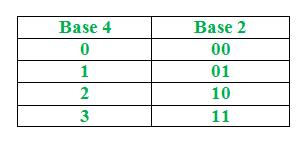Python program to convert Base 4 system to binary number
Last Updated :
20 Mar, 2023
Given a base 4 number N, the task is to write a python program to print its binary equivalent.
Conversion Table:

Examples:
Input : N=11002233
Output : 101000010101111
Explanation : From that conversion table we changed 1 to 01, 2 to 10 ,3 to 11 ,0 to 00.
Input : N=321321
Output: 111001111001
Method 1:
- Take an empty string say resultstr.
- We convert the decimal number to string.
- Traverse the string and convert each character to an integer
- If the integer is 1 or 0 then before converting to binary add ‘0’ to resultstr (Because we cannot have 01,00 in integers)
- Now convert this integer to binary string and concatenate the resultant binary string to resultstr.
- Convert resultstr to integer(which removes leading zeros).
- Return resultstr.
Below is the implementation of the above approach as follows:
Python3
def decToBin(num):
binary = bin(num)
binary = binary[2:]
return binary
def convert(num):
resultstr = ""
numstring = str(num)
for i in numstring:
i = int(i)
if(i == 1 or i == 0):
resultstr = resultstr+'0'
binary = decToBin(i)
resultstr = resultstr+binary
resultstr = int(resultstr)
return resultstr
Number = 11002233
print(convert(Number))
|
Output:
101000010101111
Time Complexity: O(n), Auxiliary Space: O(1)
Here n is the length of the no
Method 2:
Step-by-step approach:
- The base4_to_binary function takes a string num representing a number in base 4 as input.
- The function first converts the number to base 10 by multiplying each digit in the number by 4 raised to the power of its position (i.e., the rightmost digit is in position 0, the next digit is in position 1, and so on). This is done by iterating through the digits of the number in reverse order and adding the product of the digit and 4 raised to the power of its position to a variable base10.
- The function then converts the number from base 10 to binary using the built-in bin() function in Python. The bin() function returns a string with a ‘0b’ prefix, so we slice off the first two characters to get the binary representation of the number as a string.
- The function returns the binary representation of the number as a string.
Python3
def base4_to_binary(num):
base10 = 0
for i, digit in enumerate(num[::-1]):
base10 += int(digit) * (4 ** i)
binary = bin(base10)[2:]
return binary
num = "11002233"
binary = base4_to_binary(num)
print(f"The binary representation of {num} is {binary}")
num = "321321"
binary = base4_to_binary(num)
print(f"The binary representation of {num} is {binary}")
|
Output
The binary representation of 11002233 is 101000010101111
The binary representation of 321321 is 111001111001
Time complexity: O(n)
Auxiliary Space: O(1)
Like Article
Suggest improvement
Share your thoughts in the comments
Please Login to comment...